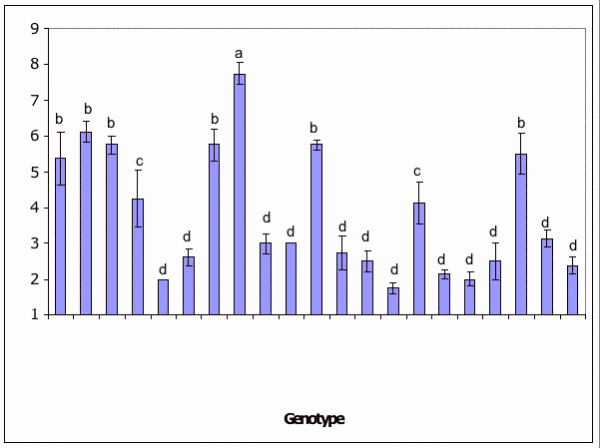Métodos simples para avaliar pelos radiculares em numerosos genotipos de feijao vulgar
Rogério F. Vieira; Celestina N. Jochua2 ; Jonathan P. Lynch2
1Epamig, CP 216, Viçosa, MG 36571-000 Brazil;
2Dept. of Horticulture, Penn State, 102 Tyson Building, State College, PA, 16803 USA
Introduction
The capacity of plants to absorb both water and mineral nutrients from the soil is related to the plant´s ability to develop an extensive and well-located root system. Of the total root surface area, root hairs can contribute up to 67 %. (Nielson et al., 2001). For determination of root hair length and density, Miguel (2004) stained roots of 14-days old plants that were observed under microscopy at 40x magnification. Using a comparative picture taken at the same magnification with micrometer scale, actual root dimensions were determined. Pictures were taken using a digital camera attached to dissecting scope and saved using Adobe Photoshop 7.0 software. Then the pictures were transferred to the Scion Image 1.63 software for root length determination at that magnification. For root hair density, a known surface area at that magnification was selected and the number of root hairs in the selected area was determined. After having root hair measurements (length and density) further calculations were made to convert to real root hair length in millimeters, and root hair density in number of root hairs per square millimeter. These calculations were made using as inputs, the picture magnification, micrometer scale and conversion of the selected root surface area to the unit of root surface area in square millimeters. Thus, root hair length (mm) and root hair density (number of root hair per mm 2 of root surface area) was determined for basal and lateral roots. This method is very laborious in a breeding program where a large number of genotypes are evaluated. The objective of this research was to test a simple method of root hair evaluation.
Material and Methods
Twenty-one genotypes were evaluated in relation to root hair density/length. Seeds of 18 common bean genotypes from Brazil were used. Eight of them are high yielding cultivars or lines (Ouro Negro, Diamante Negro, Valente, Talismã, Jalo MG-65, Carnaval-MG, Vi-4899, and Vi-10-2-1), and ten are genotypes used for disease resistance in breeding programs (AB 136, Cornell, G 2333, Kaboon, México 54, México 309, Pi 207262, TO, TU, VC-4). The genotypes DOR 364, G 19833, and Carioca were obtained from the International Center for Tropical Agriculture (CIAT). DOR 364 is known as inefficient under P-deficient conditions. Carioca is the Brazilian landrace most widely grown in the tropics, perhaps because of its tolerance of infertile soils. G19833 is a landrace from Peru that is relatively well adapted to P-limited conditions. Seeds were surface sterilized with 0.5% NaOCl for one minute, rinsed thoroughly with distilled water and scarified with a razor blade. They were placed 2 cm from the top of brown germination paper soaked in 0.5 mM CaSO 4 and with radicles pointed toward the bottom of the paper. The paper was then rolled into a moderately tight cigar roll configuration and placed in a 1 L beaker with 100 mL of 0.5 mM CaSO 4 at the bottom. Beakers were wrapped with cellophane plastic punctured with holes before being placed in a germination chamber at 28 °C. Five days later, shoots of seedlings were eliminated and roots of each genotype were separate in basal and taproots. They were conserved in 25% v/v ethanol immediately after harvest. Root hairs were visually evaluated after been stained with 0.05% trypan blue using a rating scale of 1-9 to rank the density/length as follow: 1 = no root hairs; 3 = between 1 and 5 rating scale; 5 = intermediate root hair density/length, as RILs 28 and 32, 7 = root hairs between 5 and 9 rating scale; 9 = abundant root hairs, as RILs 13 and 53. These RILs were selected from the thesis of Magalhães Miguel (2004). Data were analyzed as a completely randomized design (CRD), with each treatment replicated four times.
Results and Discussion
As seen in Fig. 1 and 2, the method worked well with relatively low SE of mean for each genotype. In general SE was lower for basal roots than for primary roots.

Fig. 1. Root hairs on basal roots 5 d after germination of 21 genotypes of common bean. Data shown are means ± SE (n = 4). Columns with different letters belong to homogenous groups by Scott-Knott test.

Fig. 2. Root hairs on primary roots 5 d after germination of 21 genotypes of common beans.
References
Miguel MA (2004). Genotypic variation in root hairs and phosphorus efficency in common bean (Phaseolus vulgaris L.). M.S. Thesis. PSU.
Nielsen KL, Eshel, A, Lynch JP (2001). The effect of phosphorus availability on the carbon economy of contrasting common bean (Phaseolus vulgaris L.) genotypes. Journal for Experimental Biology 52:329-339.

